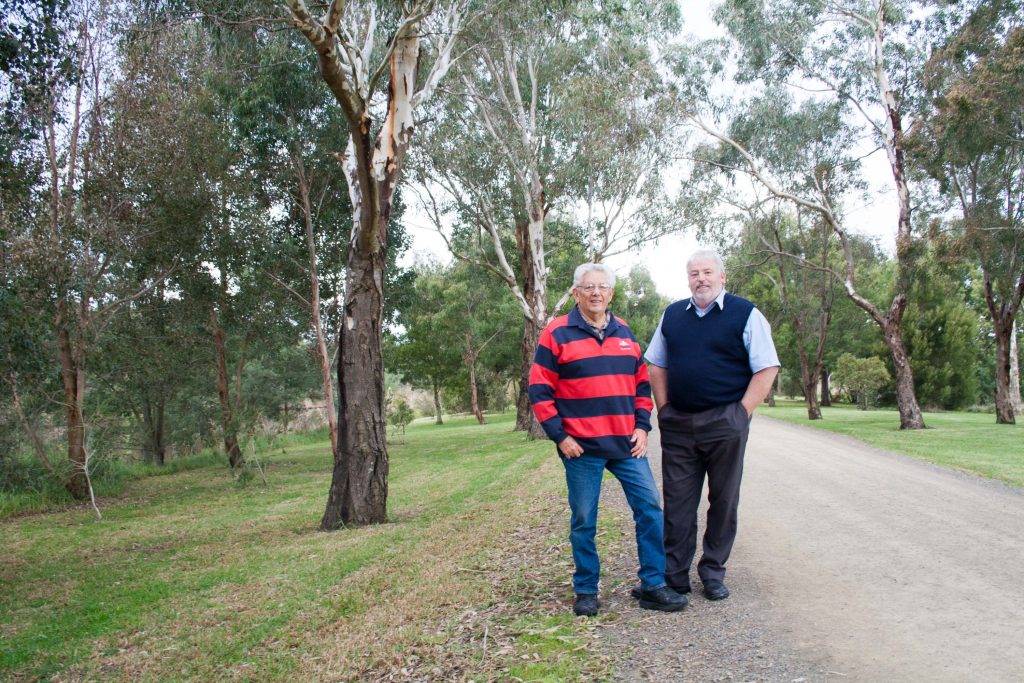
Wandering along the Mitchell River between the Lind and the Princes Highway bridges you’d be forgiven for thinking that it has always been a haven for dog walkers, bike riders and lovers of nature. In fact it has taken a concerted effort by many people and organisations over the last two decades to create the space we now enjoy.
Graeme Dear, CEO of EGCMA and Ian Clues recently re-visited the Mitchell river site, about 20 years after the latest works had commenced. Graeme said ‘The work here is an example of what many people in our community do everyday, that is recognise potential, share ideas for improvement with others and and then go about implementing changes together.’
Led by some community interest around 1997, the East Gippsland Shire Council started planning for revitalising the area which has a rich history of use over thousands of years. The Bairnsdale Urban Landcare Group was formed around that time and became a major driver for the improvements along the river. Agencies such as the East Gippsland Shire, East Gippsland Catchment Management Authority and East Gippsland Landcare Network helped with advice, funding and additional works that were proposed in the plan.
Ian Clues said, ‘It is nice to look back to when a few of our locals began this project, but nothing happens without many helpers. I was one of the people there at the beginning, but over the course of time many people and organisations have pitched in. In fact groups like the Bairnsdale Urban Landcare Group are still going strong today; a long time after I was involved, with new people joining and continuing to improve this area.’
Graeme said ’Ian was very actively involved in the development of the precinct and was recently recognised for his dedication to river health at an event in Melbourne hosted by the State Government to celebrate 20 years of catchment management across Victoria.’
As the founding President of the Bairnsdale Urban Landcare Group (BULG), Ian has focussed on improving the area to draw the community back to the river side.
“The whole place was overgrown with weeds and it was really quite thick and uninviting, there’s no way anyone would’ve walked along there, really you wouldn’t have gone anywhere near the place.” Ian says.
Years were spent removing poplars and ivy; the walking track has been upgraded with signage and the pathway improved. An adopt-a-plot initiative has allowed community and school groups to get involved with well over 100,000 native seedlings planted since 1998.
Five years on from Ian’s involvement and the impetus is still very strong. Bairnsdale Urban Landcare Group continues to protect and enhance the river banks of the Mitchell River by improving and restoring the quality of the indigenous riverbank vegetation, planting a diverse range of species suitable for this important riparian zone and creating a biodiverse habitat for fauna. The group has also established two flower plots on the northern side of the river to promote the use of local flower species in home gardens.
BULG members maintain the sites, spend many hours on weed control and plant approximately 1,000-1,500 indigenous tube stock annually. BULG contributed around $80,000 from their successful Federal and State Government grant applications, specifically to assist in the removal of the poplars at the high profile Port of Bairnsdale. The port planting began in 2010 with the Landcare group responsible for the majority of the indigenous planting which now contains around 45 different plant species including the threatened Acacia caerulescens.
The group has developed strong ties with other community groups such as the Bairnsdale Scout Group and Federation Training VCAL students and works with these organisations to instruct and educate future Landcarers. National Tree Day in July each year is now celebrated with more than 50 scouts and parents who assist in planting up to 500 seedlings in the ever-expanding scout plot on the north bank. The group was invited to participate in the 2016 Open Gardens scheme, and also took part in an East Gippsland Art Gallery project in 2015.
Recent bird surveys indicate a more than doubling of the bird species in the area, thanks to the increased plant diversity. There has been an increase in the butterfly and other insect populations, and recently wombats have returned to the north bank.
‘It takes passion and perserverence to continue a project for this long’ said Graeme. ‘We appreciate the dedication that Ian and his fellow BULG members have shown to develop a space that the entire community can enjoy.’





